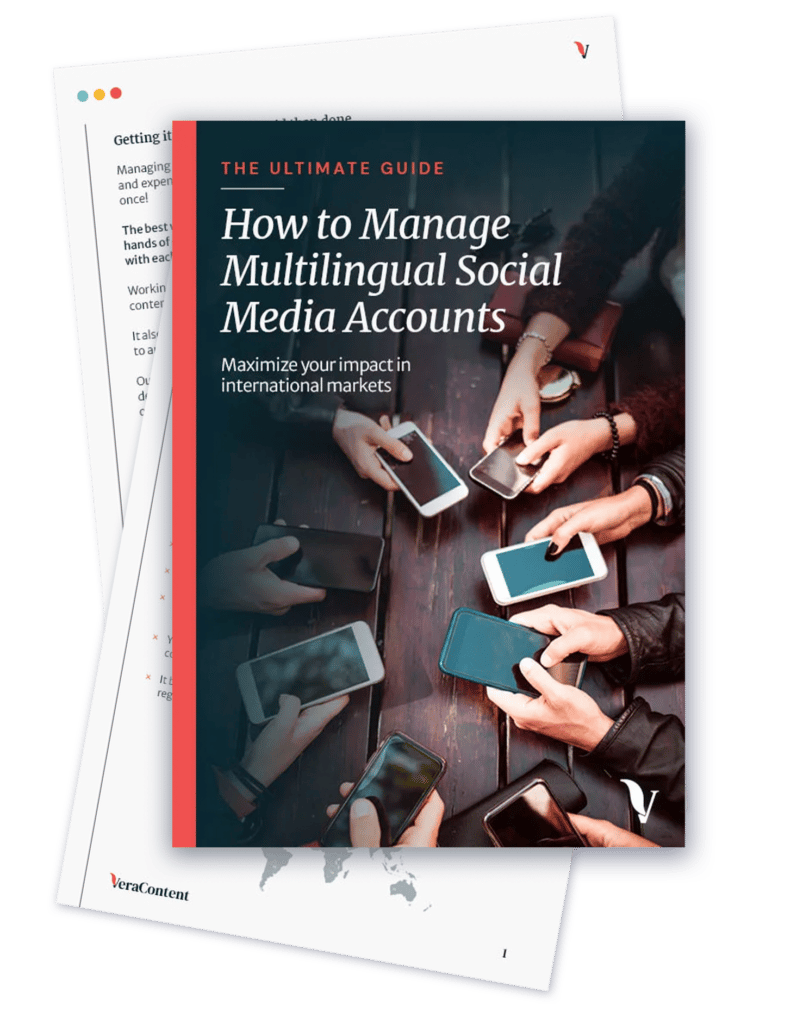Engagement is the ultimate goal on social media. High engagement levels mean you’re connecting with your online community and creating content they want to see—in other words, you’re doing it right. Plus, thanks to the algorithm, your posts are more likely to be seen with regular engagement.
If you’re writing copy for social media, your main priority should be ensuring that it truly resonates with your audience and leads to action. Below are eight tips for writing social media copy that attracts, inspires and converts. But first, why is this so important?
Why is creating engaging copy on social media so important?
When an individual follows a brand on social media, they are 91% more likely to visit the brand’s website or app. This means that the more engaging your social media copy is, the more likes and followers your brand will get—and in turn, the more traffic you’ll drive to your website.
In addition to increased traffic, there’s also the potential of getting more customers. According to a survey among small businesses, 85% of brands generate a new client or customer from social media.
However, generating those customers requires more than simply posting a few images on your Facebook and Instagram accounts. It involves creating content that interests—and converts—your audience.
And while attractive imagery is necessary, the value of your product or service is often portrayed by the copy you write.
8 tips for writing more engaging copy for social media
From post length to writing style, it’s important to always keep your audience in mind when writing copy for social media. We’ve shared eight tips below for writing social media copy that engages your audience.
1. Stop the scroll with your first line
One of your top priorities when writing copy for social media is to make it eye-catching from the first line. Our social media feeds are full of new information every time we log on, so you want your post to be the one that interrupts that morning, midday or evening scroll.
Social media is largely visual, especially Instagram, but there are a few ways you can achieve eye-catching copy. And it starts with your first line.
Your first line needs to be short, powerful and captivating. The example from Adidas below draws the reader in by providing a short fact that intrigues the reader enough to want to know more.
Bring out the intrigue, capital letters or emojis in the first line to get the user to click “read more”—while still ensuring that you keep in line with your brand’s overall style, of course. You also want the copy to complement the visual. Otherwise, it can easily be dismissed as spam, and you’ll lose loyal followers.
You may want to avoid needing that “read more” button altogether. In that case, consider leading with a question and including your CTA earlier on.
2. Pay attention to the length of your copy
The average user only uses Instagram for 30 minutes a day, so, in most cases, less is more when it comes to writing engaging copy for social media. There’s enough information thrown at us on social media already, and long paragraphs can be overwhelming. That said, there is a time and place for longer copy—like when you’re taking a stand on social issues.
Also, keep in mind that your brand’s LinkedIn account may be better suited to longer posts than Instagram.
What is the ideal social media copy length?
On Facebook, organic posts under 80 characters receive 66% more engagement. Paid posts can be longer as they’re broken down into a headline, main text and description. However, for both types of posts, brevity drives engagement.
Instagram is a primarily visual platform, so it’s usually better to let the visuals speak for themselves. For example, you can use infographics to make facts and statistics less daunting.
For sponsored content on Instagram, keep your captions under 125 characters. For organic posts, aim for the middle ground between 138 and 150 characters.
Brief copy requires less energy to read, and most people go on Facebook and Instagram to be entertained, not educated.

3. Create motivation to act now with CTAs and urgency
We’ve all said, “I’ll look at that later,” and then never go back to it. Creating motivation to act now is a dealbreaker. It’s what encourages your followers—and new users—to engage with your account.
You’re probably using CTAs in your social media copy already, but did you know that you can use stories to engage with your audience as well? A third of the most viewed stories are from businesses, and their time limit encourages immediate engagement.
While stories are more widely used on Instagram, sharing your stories on Facebook also helps to keep your account on people’s minds between posts—so don’t forget about sharing stories on both platforms.
Think about what your audience wants to engage with.
So, you’ve got your target audience, chosen platform, an idea on copy length, but what is your target market interested in seeing?
Usually, it’s something they don’t already know. You don’t want to be dismissed as old news.
Also, consider what your audience wants to talk about. They probably aren’t interested in telling you if it’s sunnier on Tuesdays or Thursdays but would love to tell you what their dog is called or share a fun memory.
Main point: Don’t throw in CTAs and questions for the sake of it—they won’t work.
4. Be a real person and show your personality
Yes, you want to gain followers, but you also want to keep those you’ve already got. The key to this is creating content that’s relevant, interesting, and definitely not cringe-worthy. Remember, most people go on social media to be entertained, so don’t be too uptight. Your social media copy should be full of personality!
As humans, we relate to other humans. So be human when writing copy for social media. Relatable content comes from people, not machines. Be conversational in your copy—it is called social media, after all.
Localizing your social media content also helps tailor your content to your audience. Trying to relate to every person on the planet is an impossible task. Instead, break it down into smaller audiences if you’re trying to have a large overall reach.
See also: Global vs. local social media accounts: Which one’s right for your business?
5. Use emojis in moderation
Emojis are an easy way to add some color and personality to your copy—and they’ve been found to boost engagement by 57%. The first thing to consider is that you’re using them in the right way and that they mean what you think.
Once you’ve made sure you’re communicating what you want to, only use them when it’s natural to do so. There are hundreds to choose from, but that doesn’t mean you need to replace each word with an emoji. They can be fun, but don’t let them detract from your overall message.
An easy way to throw in some emojis is to use them as bullet points or as part of a title.
They can also be used to show that you’re staying up-to-date with trends like this example where Grey’s Anatomy adapted Drake’s “Certified Lover Boy” album cover for their audience. It got their target audience talking and attracted other users who were familiar with the album cover.
When following trends on social media, make sure to stay relevant. Only follow the trend if it’s connected to your brand and makes sense. And remember to be timely—there’s no point in hopping onto a trend a week late!
6. Get technical and use the algorithm to your advantage
Social media algorithms decide what gets seen and in what order. Algorithms look at how often a user interacts with your account and the platform in general, how recent your post is, if your audience uses that type of post themselves and how many people they’re following—among other metrics.
Instagram implemented its algorithm in 2016, and despite the initial uproar that feeds were no longer chronological, Instagram says it helps increase exposure. Before the algorithm, people used to miss 70% of posts and 50% of their friends’ posts.
The algorithm works by placing the most engaged posts at the top of the feed. This means that creating engaging copy now will allow you to continue to reap the rewards down the line.
7. Using hashtags wisely
Hashtags do the work for you and mean people don’t have to actively look for your account. However, if you use them in the wrong way, it’s a wasted opportunity.
According to Hootsuite, nine is the optimum number of hashtags and putting them in the comments makes your post look tidier. Moreover, Instagram penalizes repetitive content so remember to mix them up.
Using popular hashtags may seem like the easy way in, but it actually adds you to a massive pool of posts, making it harder to be seen. Similarly, using very niche hashtags won’t do you any favors as people aren’t searching for #funwithfriendsintheparkonarainyday.
Try to find the winning hashtags in the middle.
What about branded hashtags?
Branded hashtags are also great for exposure and growing your audience.
The most well-known example of a branded hashtag is probably Apple’s #ShotOniPhone, with over 22 million posts. It’s a simple idea that gets people involved and talking about the brand—and shows off their camera technology.
Another example is the #GettyMuseumChallenge that started during the pandemic. The user-generated content got people talking and became a challenge rather than an ad.
8. Write for your audience on each platform
How you write copy for Instagram versus Facebook, for example, differs as the audiences using them are different. Writing engaging copy for social media depends on what your audience wants to see and finding a way to reach them.
So, when writing for each platform, make sure you know who uses that platform and how they want to engage with your posts.
Are you writing engaging social media copy?
Your social media is how you differentiate yourself from your competitors and show off your brand. Writing engaging social media copy helps you stand out from the crowd.
If you’re struggling with writing social media copy that attracts the right audience, let us help! At VeraContent, we help brands create compelling social media content—from the strategy to the imagery and copy. Plus, we specialize in localization, so we’ll make sure to create the right copy, for the right audience. Get in touch with us to find out if you qualify for a free content consultation.
Download our ultimate guide on how to manage multilingual social media accounts:

For more tips on how to write engaging copy for social media:
- 6 ways to boost your creativity as a content writer
- 5 reasons why you should stop trying to create perfect content
- 11 ways to make your brand more human
- Global vs. local social media accounts: Which one’s right for your business?
- How important is subtitling on social media?
- The value of transferable creative skills in the marketing world: 10 inspiring stories
- How to build successful relationships with local community managers

